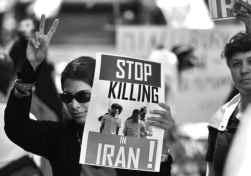
My name is Arsham Parsi, a 37-year-old gay man born and raised in Iran. Neither of these facts were my choice. Discovering my difference from other men—not being interested in women—terrified me because I could be killed for who I was.
Homosexuality is punishable by death according to Iran’s Sharia law. The only disagreement among Islamic clergy regarding LGBT people is how to kill them. Some believe that they should be stoned to death, others that they should be hanged or cut in half by a sword or thrown from a mountain or a big cliff or a tall building. I was so afraid as a teenager. This step backward in basic humanity was an unwanted gift left over from the Islamic revolution.
It was my choice to flee into exile upon finding out the Iranian authorities were looking for me because of my activism helping other oppressed and vulnerable LGBT people. I left Iran for Turkey and applied for asylum at the United Nations High Commissioner for Refugees in Ankara. This was one of the most difficult periods of my life. finally, I was one of those lucky few who was recognized as a refugee and resettled in Canada where I established the International Railroad for Queer Refugees (IRQR). Canada gave me a second chance at life. I was able to help my LGBT brothers and sisters, publish my memoir, Exiled For Love, and begin to talk to the media about the plight of not only Iranian LGBTs, but the larger Middle Eastern LGBT community.
However, it was not the end of my challenges. After my departure for Canada, my family became a target of the Iranian regime, and they had to leave their entire life behind because of my increasingly visible activism. But they supported my work, never blamed me for this turn of events, and have now joined me in the safety of Canada.
We celebrated IRQR’s 10th anniversary in 2018, which is no small accomplishment. This milestone represents 10 years of raising awareness, of fighting against injustice, of supporting refugees, of working closely with families and friends of LGBT members worldwide. More importantly, it represents 10 years of making a significant difference in the lives of hundreds of LGBT individuals and even saving lives.
2018 was my 18th year of working for this cause. Unfortunately, this also represents 18 years of being harassed, of receiving death threats, and being targeted by the Iranian regime and its loyal allies in Europe and North America.
Indeed, for me it was 18 years filled with unspeakably difficult moments. But the support of thousands of people from around the world encouraged me to continue. This made me more determined than ever to fight for our rights, and I am forever grateful to them.
However, we have a long way ahead of us. Recently, many Western countries have closed their eyes to the blatant persecution of LGBT people in Iran and have basically abandoned us. Since President Trump took office, he has banned Iranian LGBT citizens who have escaped from the Iranian regime and sought asylum in the US.
More than 1,800 LGBT refugees are stuck in Turkey with no support because Trump assumed that they are all the Tehran regime’s allies. This initially caused outrage in the US, but the situation has now been nearly forgotten.
Trump’s strategy, like that of the former Iranian president, Mahmood Ahmadinejad, is to make daily media distractions hoping citizens will forget what happens outside their borders. Initially, Trump ordered a 120-day temporary halt on the processing of refugee applications. Two years have passed and still no applications have been processed.
In the meantime, the Iranian regime still actively persecutes homosexuals. According to a 2008 British WikiLeaks dispatch, the Iranian regime executed between 4,000 and 6,000 gays and lesbians since the Islamic Revolution in 1979, meaning almost one person every 58 hours. Many LGBT people languish in Iranian prisons, while others commit suicide.
Iran’s legal system is very complicated and lacks transparency. This often means that lawyers, journalists, and human rights advocates do not have access to critical information regarding human rights abuses.
Under Iran’s Sharia Law, lavat (sodomy) or Lavat-e-be-onf (sodomy involving an underage individual) refer to any sexual act between two same sex individuals. Typically, the narrative propagated by the Iranian courts is that lavat occurs amidst rape, kidnapping and “immoral behavior.” Because no information is available from alternative sources, the task of separating fact from homophobic propaganda is all the more difficult, if not impossible.
It is impossible to know whether the executed individuals were homosexuals who were accused of other crimes, which would conveniently support the narrative that homosexuality and criminality overlap. In many cases the regime may not have a legal reason to execute an individual, and therefore accuses him or her of the crime of homosexual acts in order to justify the punishment that follows. All of this reinforces the persecution of LGBT people in Iran.
We, the people, can and need to take care of each other.
Arsham Parsi’s recent book, Exiled for Love: The Journey of an Iranian Queer Activist, is available from FernwoodPublishing.ca. To help persecuted LGBT people, visit IRQR.
